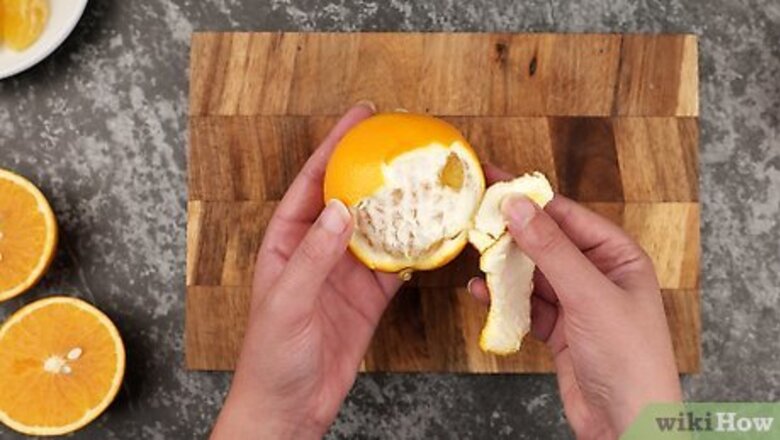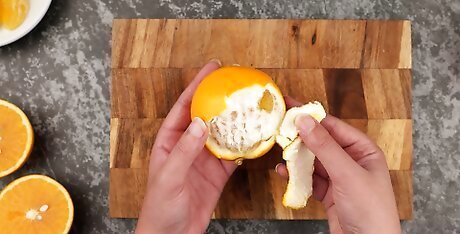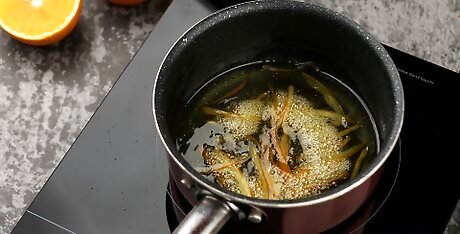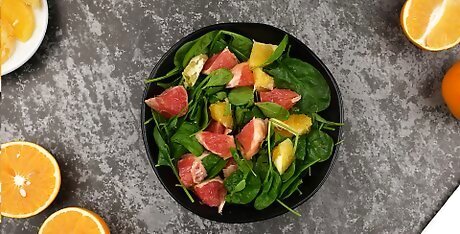
views
Peeling and Cutting Oranges

Peel an orange by hand. Dig a metal teaspoon or a knife into the peel and tear a bit of the peel off. Once you can get a good grip on the peel with your hand, put away the knife or spoon, and pinch the edge of the "gap" you made. Pull as much of the skin away as you can. Keep peeling the skin until it is all gone. If there are any stringy bits, pull those off too. Pry the orange open before you eat it. Stick your fingers into the hole at the top of the orange, and pry it open like a book. Separate the wedges, and eat them individually. Be sure to pick out any seeds, or to spit them out.

Peel an orange with a spoon or fork handle. Slice an orange across the equator, going only through the skin, and not the flesh. Use a serrated knife. Next, take a spoon or fork with a flat, curved handle. Stick handle into one side of seam, pointing it towards the top of the orange. Run handle all around orange, prying the peel away from the flesh. Repeat for other side of the seam. When you are done, pull the peel away from the orange, like a hat or sock. Try rolling the orange around on table before you peel it. This will loosen the orange from the skin and make it easier to peel.

Cut an orange into a strip. Place the orange down sideways on a cutting board, and cut the top and bottom off. Next, cut a slit into the side of the orange, all the way down to the core. The slit should go from one cut end to the other. Finally, use your fingers to pry open the orange, like a book, into a long strip. Use your fingers to pull the orange segments off of the peel, and eat them. Don't cut too much; about ½ inch (1.27 centimeters) off of each end will be enough. This method works best for Mandarin oranges, but many people find that this works with regular oranges as well, such as Valencia.

Cut an orange into wedges. Place an orange down on a cutting board, with the stem part facing upwards. Slice it in half, then place each half face-down on the cutting board. Cut each half into wedges. Start by cutting it in half, straight down. Then, make two cuts to either side, angling your knife towards the center of the orange. Eat the orange directly from the peel. Place the flesh part of the orange into your mouth, with the peel between your lips like a big, orange smile. Bite down slightly, and suck the juices out.

Cut an orange into crescents. Place an orange down on a cutting board with the top/stem facing upwards. Slice the orange in half, then place each half face-down on the cutting board. Cut each half into ½ inch (1.27 centimeters) thick slices. Start at one end, and finish at the other. To each the slices: hold the slice between your fingers, and tear the flesh part away with your teeth or fingers and eat.
Choosing and Eating Oranges

Choose ripe oranges. Like most types of citrus, oranges do not ripen once you harvested. Choose oranges that are bright in color. Store them at room temperature, away from sunlight. Winter is the peak season for oranges. Studies have shown that keeping fruit in a bowl on the counter makes them more tempting to eat.

Add some oranges to your fruit salad. Slice up some strawberries, and add them to a bowl with grapes and canned pineapple cubes. Peel an orange, pull apart the wedges, and cut them in half. Add the sliced wedges to your salad.

Garnish your lunch or dinner salad with sliced up orange wedges. Peel an orange, pull apart the wedges, and slice them in half. Add them to a bowl of lettuce or spinach, and top with toasted walnuts/pecans and crumbled gorgonzola cheese. Toss the salad with a balsamic or sweet citrus dressing. Consider adding some pomegranate seeds as well.

Toss some orange into a salad with other citrus.

Squeeze oranges into juice if you don't like the texture of the flesh. Simply rinse an orange and cut it in half. Squeeze the juice out using a juicer, and pour the juice into a glass.

Save the peel and candy it. Instead of tossing the peel, rinse it and cut it into thin slices. Boil the orange peel in water and sugar. For extra goodness, try dipping the candied peels in melted chocolate. Let the chocolate harden before enjoying them. Other ways to eat orange peels include adding them to smoothies, marinades, vinaigrette dressings, muffins, and marmalade preserves.
Eating Oranges for Health

Eat oranges as a post workout snack. The water in the orange will help re-hydrate your body, while the carbs and potassium will help restore energy. Consider pairing the orange with a hard boiled egg. Eggs contain fatty acids that prevent and reduce inflammation damage.

Eat oranges to boost your immune system. Oranges are high in vitamin C, as well as other vitamins. They help improve your immune system, and protect you against viruses and infections, including the common cold.

Eat oranges to make your skin look younger. Oranges help build collagen, which helps make your skin more elastic. This, in turn, helps reduce wrinkles and make skin appear younger. It also helps even out skin texture.

Eat oranges to lower cholesterol levels and blood sugar. Oranges are low in fat but high in fiber, making them the perfect diet food, as well as an ideal snack for those struggling with high cholesterol and diabetes.

Know that too much of one thing is not good for you. While eating orange is good for you, eating too many is not. The more you eat orange does not mean that you will lose weight faster, or get over a cold faster. Limit yourself to one orange a day. Eating too many oranges can lead to digestion problems, including stomach cramps and diarrhea.




















Comments
0 comment